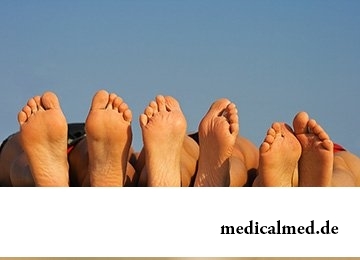





Syndrome of uneasy legs
 The state at which the person feels the unpleasant feelings in the lower extremities (more rare in upper) causing insuperable desire to move legs or hands is called the syndrome of uneasy legs (SUL).
The state at which the person feels the unpleasant feelings in the lower extremities (more rare in upper) causing insuperable desire to move legs or hands is called the syndrome of uneasy legs (SUL).
The people suffering from this syndrome note that unpleasant feelings, as a rule, appear at rest in the evening or at night, in particular in a prone position or sitting. In certain cases SBN leads to serious violations of a dream and in 15% of cases is the reason of an insomniya (chronic sleeplessness) that considerably influences quality of human life.
Symptoms of a syndrome of uneasy legs can be lungs and not cause special disturbance, and happen intolerable and to drive the patient to despair. The syndrome occurs among all age categories, however much more often people of middle and advanced age suffer from it.
In 20% of cases of SBN occurs at pregnant women, the symptomatology is shown in the II—III trimester, and after delivery completely disappears.
Syndrome of uneasy legs: reasons
Emergence of SBN in 20% of cases is connected with deficit or the wrong redistribution of iron in an organism, such diseases as can be other reasons of a syndrome of uneasy legs:
- Varicosity and venous reflux;
- Deficit of folic acid, vitamins of group B and magnesium;
- Fibromyalgia and uraemia;
- Apnoea in a dream and a diabetes mellitus;
- Diseases of a thyroid gland;
- Peripheral neuropathy;
- Amyloidosis and resection of a stomach;
- Parkinson's disease and Shegren's syndrome;
- Gee's disease and pseudorheumatism.
Emergence of a syndrome of uneasy legs is not excluded and at a cryoglobulinemia, alcoholism, chronic obstructive diseases of lungs, a hypothyroidism and a thyrotoxicosis, porphyrias, an obliterating disease of arteries, a radiculopathy, damages of a spinal cord, an essential tremor, a disease of Gentington, a side amyotrophic sclerosis and fibromyalgia.
At absolutely healthy people SBN, as a result of the postponed stress, an intensive exercise stress and the use in a large number of the drinks containing caffeine is also sometimes shown.
Also as the reason of emergence or aggravation of a syndrome of uneasy legs reception of such drugs as can act:
- Antiemetics;
- Antidepressants;
- Antihistamines;
- Antipsychotic and some anticonvulsant drugs.
The significant role is played also by a genetic factor – nearly a half of the uneasy legs of people suffering from a syndrome are members of families where the disease passed from father to son.
SBN symptoms
The symptom by emergence of the unpleasant feelings pricking, scraping, itching, pressing or arching character in the lower extremities is characterized. Manifestation of symptoms generally happens at rest, at physical activity they considerably decrease.
For simplification of a state patients resort to various manipulations – extend and bend, mass, stir up and pound extremities, during sleep often turn, get up and go here and there, or shift from one foot to the other. Such activity helps to stop manifestation of symptoms of a syndrome of uneasy legs, however as soon as the patient goes to bed again, or just stops – come back.
Characteristic sign of a syndrome is manifestation of symptomatology at the same time, on average it reaches the maximum expressiveness during the period from 12 o'clock in the morning to 4 mornings, minimum it falls on time from 6 to 10 o'clock in the morning.
In the started cases, at a long absence of treatment, the day-night rhythm of a syndrome of uneasy legs disappears, symptoms are shown at any time, is even able sitting. Such situation considerably complicates life to sick – to it difficult to maintain long trips in transport, to work at the computer, to visit cinema, theaters, etc.
Because of need to constantly carry out the movements during sleep over time at the patient sleeplessness which results in bystry fatigue and drowsiness in the afternoon begins.
Diagnosis of a syndrome of uneasy legs
The specific medical analysis for diagnosis of a syndrome of uneasy legs does not exist, however, performing blood test and urine can help to exclude other diseases.
Diagnosis of SBN is carried out on the basis:
- The symptoms described by the patient;
- The answers to questions concerning health of relatives;
- The patient's poll about the medicines used earlier.
The important part is assigned to a dream – so if the patient prefers to sleep in the afternoon, because of emergence of discomfortable feelings in extremities in evening or night time, it is possible to assume the diagnosis of SBN.
Treatment of a syndrome of uneasy legs
The main treatment of a syndrome of uneasy legs is directed to reduction of symptoms, decrease in day drowsiness and improvement of quality of life of the patient.
 Before starting direct treatment, it is initially necessary to define the reason which served to emergence of a syndrome. So, if it becomes clear that SBN is a consequence of reception of medicines – it is necessary to cancel them. In cases when the syndrome is a symptom of other disease – it is necessary to treat a basic disease.
Before starting direct treatment, it is initially necessary to define the reason which served to emergence of a syndrome. So, if it becomes clear that SBN is a consequence of reception of medicines – it is necessary to cancel them. In cases when the syndrome is a symptom of other disease – it is necessary to treat a basic disease.
Treatment of a syndrome first of all has to be directed to completion of the available deficit of iron, vitamins of group B, magnesium, folic acid, etc. The medical institution can apply both medicamentous, and non-drug treatment.
Patients are recommended to take an evening shower, to keep to the balanced diet, to refuse smoking and alcohol intake, to carry out a moderate exercise stress, to exclude caffeine - the containing drinks and products in the evening, and also to carry out foot walks before going to bed.
The syndrome of uneasy legs is a state at which the person feels discomfortable feelings in extremities because of what the patient has an insuperable desire to move legs (or hands). Timely diagnosis and treatment of a disease allow to get rid of the symptoms accompanying a disease completely.
Was considered earlier that yawning enriches an organism with oxygen. However this opinion was disproved. Scientists proved that yawning, the person cools a brain and improves its working capacity.

Zone hypostases under eyes - very widespread problem giving to people is a lot of inconvenience. Hypodermic fabric in these parts having...
Section: Articles about health
The chia plant, or the Spanish sage, is from South America. The indigenous people of the continent since ancient times used its seeds in food: small, but very nutritious kernels, in a form the reminding fasolina. Indians knew about useful properties of seeds of a chia, and applied...
Section: Articles about health
For most of the working people the problem of having a snack is particularly acute enough. Sooner or later there is a question: what can be eaten quickly between a breakfast and a lunch or a lunch and leaving from service so that to receive necessary power feed, but not to overload an organism with harmful components or excess calories? We bring to your attention the list of products which quite conform to these requirements....
Section: Articles about health
History of mankind contains several tens of epidemics whose emergence was compared by eyewitnesses and historians to doomsday. With...
Section: Articles about health
The stroke is one of the most widespread diseases of the person, annually in the world about 6 million cases of this pathology are registered. According to medical statistics, strokes occur almost three times more often than myocardial infarctions. Disease otno...
Section: Articles about health
Cold is such painful that each sigh becomes a victory, heat "knocks" down, and the ache in joints forces to think only of pain. Some people with approach of the first symptoms of cold make the self-sacrificing decision to have a disease standing, and at best to rest in bed with a cup of hot tea. There is an opinion that if not to treat cold, then the organism itself, sooner or later, will overcome an illness. Whether so it? It is known that if in time it is simple not to begin treatment, apparently, harmless...
Section: Articles about health
For the city dweller the fitness is the most convenient sport. It is enough to acquire the subscription to the gym to receive to a toast...
Section: Articles about health
All like to sing. Small children with pleasure are engaged in a vocal, not especially thinking of hit in a melody. Adults most often hesitate, being afraid to show lack of talents in this area, and it is vain: singing is very useful for health....
Section: Articles about health
Helminthosis is one of the most widespread diseases. Statistically, any species of helminths infected every third inhabitant of the planet. Most of specialists even consider these data strongly underestimated: some uninvited "cohabitants" do not cause the carriers serious troubles, and patients just do not see doctors. The situation is aggravated also with the fact that people know about specifics of similar illnesses very little. At many presence of worms is strong ассоциир...
Section: Articles about health
The hysteromyoma is diagnosed more than at a third of women 35 years are more senior. This high-quality new growth, which on early a stage...
Section: Articles about health
Run - one of the most available and effective ways to revitalize the organism. Knowing about its extraordinary advantage, each of us at least once tried to make jogs, but only the few made these occupations regular. In spite of the fact that in jogging (easy an ozdor...
Section: Articles about health
The kid who was recently born is surrounded with love of adult family members and their cares without which the baby cannot exist. Some parents consider that gentle attachment and caress are quite enough that the child correctly developed and was happy, but it not so. It is important to know as much as possible about specifics of care of the baby, the reasons of his behavior and possible problems. Only the "able to see" love will provide to the little man that it is necessary for him....
Section: Articles about health
Several decades ago the basil (the district khan, реан, Reagan) was considered as a part of the Caucasian or east cuisine, but today it is strong for...
Section: Articles about health
The brain of the person is studied not one hundred years, but the quantity of the riddles connected with this body increases rather, than decreases. Perhaps, numerous delusions concerning a structure and functioning of a brain, many are explained by it from...
Section: Articles about health
From the failure of work of immune system which is shown in the form of an allergy, statistically, more than 40% of the population of the globe suffer. In most cases pathological reactions cause the substances which are contained in food stuffs, hair of animals, medicines, goods of household chemicals, cosmetics, pollen of plants, etc. On the one hand, the disease such is capable to spoil quite thoroughly to the person life....
Section: Articles about health
For anybody not a secret that our country is one of the most "drinking" in the world. At clear understanding of that the use of strong...
Section: Articles about health
Tuberculosis – a serious infectious disease which development is caused by mycobacteria (Koch's bacilli). The illness is known from an extreme antiquity. Long time fight against it was considered as ineffective. Quite often the disease affected the whole families, and mortality from it was very much...
Section: Articles about health
The metabolism at each person proceeds in own way. However between the speed of this process and disposal of excess weight after all all have a dependence. Unfortunately, the people inclined to try on itself numerous "miracle" diets, not always consider this circumstance and with the most resolute intentions begin to eat so that artificially slow down the metabolism instead of to accelerate it. Except quite clear disappointment, incorrectly picked up systems...
Section: Articles about health
Iodine - one of thirty most important microelements in our organism. The main role of iodine consists in synthesis thyroid гормо...
Section: Articles about health
Small appetite at the child – the complaint which pediatricians should hear practically from each mother. Most often it is carried to the category of children's whims, however the refusal of food in certain cases can be to alarming symptoms therefore it cannot be ignored....
Section: Articles about health
For the time being the perspective of heart diseases seems to most of people remote and foggy. But sooner or later practically each adult faces extremely unpleasant feelings: sudden stethalgia. To be consoled at this time in a thought of what for a heart attack still early, will hardly turn out: if the person is impressionable, he, as a rule, has feeling of panic and fear of fast death. And meanwhile, it is very often possible to confuse pains with cardiac pains невралгическог...
Section: Articles about health
Heart disease and blood vessels lead to disturbance of blood supply of bodies and fabrics that involves failures in their works...
Section: Articles about health
Bathing in broths of medical flowers and plants (phytobathtub) was eurysynusic since Cleopatra who is a good judge in all that concerns beauty and health. And today phytobathtubs is the simple and available means allowing not only to remove nervous N...
Section: Articles about health
About 20% of the population of our planet have a hypertension (permanent increase in arterial pressure). This disease has an adverse effect on the standard of living, reduces working capacity, and in the absence of systematic treatment threatens with such complications as a myocardial infarction, a stroke and other heavy illnesses which can result in disability or sudden death. Most of patients for maintenance of pressure at more or less acceptable level accept appointed doctors лекарст...
Section: Articles about health
An eye of the person daily experiences considerable strain. The problem of preservation of sight is for many years directly connected with a question снабж...
Section: Articles about health
Food with the increased content of sugar is attractive to most of people - it is scientifically confirmed fact. Business here not in intemperance or dissoluteness: the sweet food is associated since childhood with feeling of rest and safety which is felt by the kid, to...
Section: Articles about health
Physical activity is necessary for normal functioning of a human body. At a lack of the movement joints cease to function, muscles atrophy, cardiovascular activity is broken and the metabolism worsens. The modern city rhythm of life does not provide the person with an adequate exercise stress, additional - sport is necessary. Tedious tasks the huge number of the people having those or ин exists sport not all to liking, but also...
Section: Articles about health
